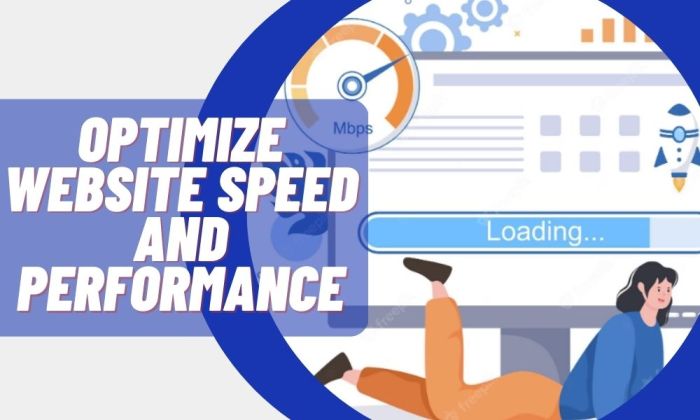Kicking off with Optimizing Website Speed, this topic delves into the crucial aspects of website speed optimization. Slow loading times can have a significant impact on website performance and rankings, making it essential to understand the factors affecting speed and techniques to improve it.
Importance of Website Speed Optimization: Optimizing Website Speed

Optimizing website speed is essential for ensuring a positive user experience. When a website loads quickly, users are more likely to stay engaged and navigate through the site, leading to higher conversion rates and customer satisfaction.
Slow loading times can have a detrimental impact on website performance in several ways. For instance, users may become frustrated and abandon the site if pages take too long to load. This can result in a high bounce rate, lower engagement, and ultimately, a loss of potential customers.
Relationship Between Website Speed and Rankings
Website speed plays a significant role in determining the rankings of a site. Search engines like Google consider page speed as one of the ranking factors, with faster loading times typically leading to better search visibility.
- Improved User Experience: A fast-loading website provides a better user experience, which can lead to lower bounce rates and increased time spent on site.
- Mobile Optimization: With the rise of mobile usage, having a speedy website is crucial for mobile optimization and rankings.
- Crawlability: Search engine bots can crawl and index a website more efficiently if the pages load quickly, potentially leading to higher rankings in search results.
Factors Affecting Website Speed
When it comes to website speed, there are several key factors that can influence how quickly a website loads for users. Factors such as image sizes and formats, as well as server performance, play a crucial role in determining the overall speed of a website.
Image Sizes and Formats Impact
Images are an essential part of web design, but they can also significantly impact loading times if not optimized properly. The size and format of images used on a website can greatly affect how quickly the site loads. Large image files take longer to download, slowing down the overall loading time of a webpage. It is important to compress images and use the right file formats, such as JPEG or PNG, to ensure faster loading speeds.
Role of Server Performance
Server performance is another critical factor that influences website speed. The server where a website is hosted plays a crucial role in how quickly content can be delivered to users. A slow or overloaded server can lead to delays in loading times, frustrating visitors and impacting the overall user experience. It is essential to choose a reliable hosting provider with good server performance to ensure fast website speed for users.
Techniques for Optimizing Website Speed

When it comes to optimizing website speed, there are several techniques that can make a significant impact on the performance of your site. From minimizing CSS and JavaScript files to utilizing browser caching and content delivery networks (CDNs), there are many strategies you can employ to ensure your website loads quickly and efficiently.
Minimizing CSS and JavaScript Files
One of the best practices for optimizing website speed is to minimize the number of CSS and JavaScript files used on your site. Combining multiple files into one can reduce the number of server requests required to load your website, ultimately speeding up load times. Additionally, removing any unnecessary code or whitespace from these files can further optimize performance.
Benefits of Browser Caching, Optimizing Website Speed
Browser caching is a technique used to store static files, such as images, CSS, and JavaScript, locally on a user’s device. By enabling browser caching, you can reduce the time it takes to load your website for returning visitors, as their browsers can retrieve these files from their cache instead of downloading them again from the server. This can lead to significant improvements in website speed and overall user experience.
Content Delivery Networks (CDNs)
Content delivery networks (CDNs) are servers distributed geographically around the world that store cached copies of your website’s files. When a user accesses your site, the CDN delivers these files from the server closest to their location, reducing the physical distance data needs to travel and speeding up load times. By leveraging CDNs, you can ensure faster loading times for users worldwide and improve overall website performance.
Tools for Measuring and Monitoring Website Speed
When it comes to making sure your website is running at top speed, having the right tools in your arsenal is crucial. Let’s dive into some of the key tools you can use to measure and monitor your website’s performance.
Google PageSpeed Insights
Google PageSpeed Insights is like your website’s personal trainer, giving you a detailed analysis of your site’s speed and performance. By simply entering your website’s URL, you can get valuable insights into what’s working well and what needs improvement. It provides suggestions on how to optimize your site for better speed and user experience.
GTmetrix
GTmetrix is another powerful tool that helps you identify areas for improvement on your website. By running a speed test, GTmetrix generates a detailed report showing you where your site is slowing down. It provides actionable recommendations on how to fix these issues and improve your website’s overall performance.
Importance of Regular Speed Tests and Monitoring
Regular speed tests and monitoring are essential for maintaining optimal performance. By consistently measuring your website’s speed, you can identify any issues early on and take steps to address them. This proactive approach ensures that your site is always running smoothly and providing the best possible experience for your visitors.